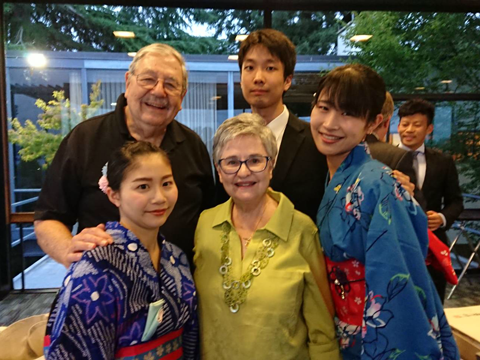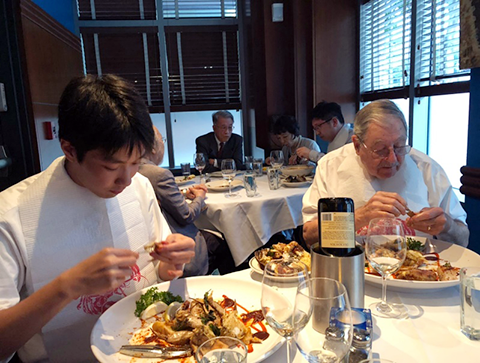国際・国内交流
岩田 啓吾さん(第5学年次)
ワシントン大学研修に参加して
私はこの2019年8月3日~9日までシアトルのワシントン大学で医療倫理・生命倫理を学ばせてもらいました。またこの留学においては、単に医療倫理について学ぶだけではなく、アメリカの医療施設も見学する機会がありました。私自身、最初は後者に惹かれてこのプログラムに応募したのですが、実際に様々なレクチャーを受け、先生方とディスカッションする中で、非常に自身にとって有益な考え方・経験を得ることができました。以下では、はじめに当プログラムで学ぶ医療倫理への誤解と私なりの解釈、次に印象に残ったレクチャーを2つ紹介したいと思います。
まず私がこの留学に行く前、これから“何が良くて何が悪いのか”…といった基準について学ぶものだと考えていて、正直なところ得られるものは少ないかもしれないと考えていました。しかし、実際に学んだのは、次にも一部紹介しますが、実際の医療において倫理的問題と遭遇した時にいかにして対処するか、その方法論についてでした。加えて言えば、方法論だけではなく、なぜ医療倫理の4原則を定める必要性があったのかなども学びました。つまり私たちが当プログラムで実際に学んだのは、良い悪いといった基準ではなく、そういった基準に照らし合わせるために臨床的な情報をまとめるか…といった非常に臨床的な手法を学ぶことができたのです。(もちろんそれ以外にも学びましたが、一番の幹はこれであったように感じます。)
次に実際に学んだものの中で、印象に残ったものを2つ取り上げたいと思います。1つ目は”4 box method”です。これは初日にDr. McCormickのレクチャーの中で取り上げられ、このプログラムの中の核となるような考え方です。医療現場において、倫理的問題に出会った時、Medical indications/Patient Preferences/Quality of life/Contextual Featuresの4ブロックを埋めながら考えることで、解決にあたって過不足ない情報を集められる方法です。ではこれを実際どのように用いるかが問題となってきます。この4 box methodを臨床的に用いているのがSeattle children’s hospitalでPalliative Care for Pediatric Patientsにおいてです。そこで使われる4box methodはカルテのように時系列を追いながら、患者が何を大切にしているか推移を記述できます。こうすることによって患者の大事にしているもの、つまりは価値観をもれなく記述することができ、患者自身の基準に沿ったケアができるのです。
2つ目は、Dr. James Greenによるアメリカでの安楽死の実際についてです。アメリカのオレゴン州は安楽死が最初に認められている州で、そこでは医師の補助による安楽死が行われています。日本では安楽死は認められていないため、安楽死がどのように行われるのか知りませんでした。しかし講義の中で以下のことが語られました。“実際に使用される薬物はバルビツレート系のピルであり、医師が直接患者に手渡し患者が自分自身で服用します。このピルの処方は医師なら誰でも可能であるが、やはり多くの医師はピルを処方したくないと考えています。”正直なところ、この内容に対して大きな衝撃を持ったことを覚えています。将来的に自身の人生に関わってくるかどうかはわかりませんが、このレクチャーの内容、そしてこれがその当事者から語られた雰囲気を知ることができたことは、今回の留学で得られた大きな収穫だと思っています。
このようなレクチャー以外の施設見学およびプライベートな観光もまた非常に充実したものでした。この中で個人的に非常に印象深かったのは、King先生のホームパーティーであったと思います。このような大人数を家に招いてもらい、料理や飲み物を振舞ってもらい、先生のお子さん達に家の中を案内してもらったりしました。加えて、King先生やMcCormick先生、そしてKing先生のお子さん達とゆっくりおしゃべりする時間もいただけました。
少し脱線しますが、このようなプライベートでのやり取りの中で特に嬉しかったことは、King先生・McCormick先生が将来的な臨床・研究留学を応援してくれたことです。もともとこのプログラムに応募した理由のひとつに、将来的な留学を考える上での判断材料を得る…というものがありました。おふたりの先生にこのプログラムの期間で、以上のようなことを考えて現在準備中であることを伝えると、“Please let me know if I can be of help in the future”と応援してくださったり、連絡先を交換してくれるなどサポートをしていただきました。
最後になりましたが、このようなプログラムを支えてくださった山西先生そして枚方療育園のスタッフの皆様、現地にてレクチャーやそれ以外のプライベートな食事でもお世話になったKing先生・McCormick先生、近藤先生、中村先生、家に招いてくださったKing先生の家族の皆様などには心から感謝申しあげます。遠いシアトルで有意義な時間、そして新たな出会いを享受できたのは、多くの方に支えられてのことだと思いました。ここでできたつながり、そして経験は貴重な宝物です。今一度、このプログラムを支援してくださった方に感謝を伝えたいと思います。ありがとうございました。

